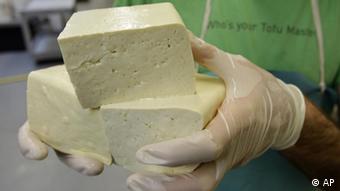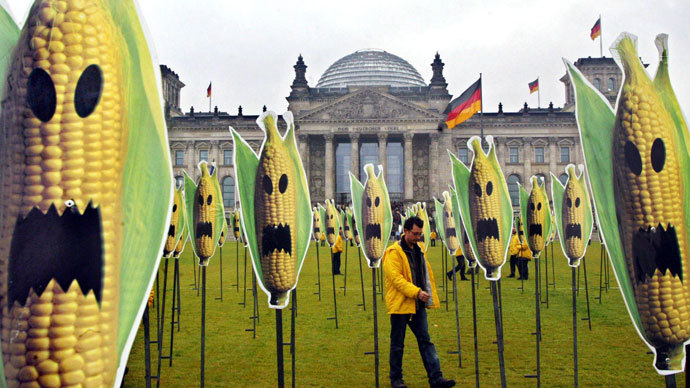For years, a community near Córdoba, Argentina was slowly poisoned with pesticides. But even as awareness and protests against pesticide use grew, so did the support for the chemicals to promote crop growth.
"When he was four years old, he came down with the illness that left him temporarily paralyzed," she recalls. "He was admitted to the hospital. They told me that they didn't know what was wrong with him."
It was a suffering not brought on by natural causes: "If I had known that it was the fumigation, that after the planes went by this would happen to my son, I wouldn't have let him play in the soy fields," she says.
The Gaticas lived just fifty meters from fields planted with genetically-modified soy. Planes regularly flew overhead, spraying the plants with the herbicide glyphosate. Slowly, the entire suburb started getting sick.
 Soybean plantations in Argentina abound
Soybean plantations in Argentina abound
"Children were being born with deformities," Sofia says, "little babies were being born with six fingers, without a jawbone, missing a skull bone, with kidney deformities, without an anus - and a lot of mothers and fathers were developing cancer."
In 1999, Sofía Gatica gave birth to her fourth baby, a little girl. Three days later, the baby died of kidney failure. The loss of her child prompted Gatica to take action. She decided to find out what was happening in her neighborhood: She started knocking on doors and asking questions.
"I went door-to-door and did a survey - asking each mother for the sick person's name, address, clinic, everything. And each mother sent me to another, and to another, and so on."
Major health consequences
From there, things began do develop a dynamic of their own: "The mothers started to come help me, to tell me, 'Look, I have another sick person.' They came to me by themselves; they decided to join the struggle." Armed with their survey, Mothers of Ituzaingó, as they called themselves by then, approached the government and demanded an investigation. In 2002, the government agreed to one.
 Soybean harvest in Argentina - waiting to go to market
Soybean harvest in Argentina - waiting to go to market
The results were alarming: The area's water supply was polluted, and eighty percent of the neighborhood's children had agrotoxins in their blood. And more was to come: Around this time, a doctor at the University of Buenos Aires - Andrés Carrasco - proved that the herbicide glyphosate can cause birth defects in vertebrates. "In most cases, the fetus dies before birth because of its deformities," Carrasco explains, "that is to say, the inhalation or the introduction of these agrotoxins kills the embryo."
Yet, surprisingly, not everyone views glyphosate as a danger. César Soldano has been farming in Córdoba and the nearby province of Santiago del Estero for three decades. He plants soy and corn in the spring and summer, and wheat and garbanzo beans in the winter.
The land where he now farms wasn't productive until he started using genetically-modified soy beans and the glyphosate herbicide:
"This was all scrubland," Soldano says, gesturing to his fields, which stretch as far as the eye can see. He says glyphosate enabled him to transform the landscape.
Short-term help
"Monsanto's 'Roundup-Ready' soy means that the soil doesn't have to be turned," Soldano continues. "The glyphosate destroys all plant growth except the soybean. This makes it possible to conserve water and grow crops."
 Argentine soy is considered essential for the food supply of the future
Argentine soy is considered essential for the food supply of the future
Soldano drives around his fields, describing his irrigation system and explaining that today's green shoots will soon become garbanzo plants. Before the arrival of glyphosate, he says, farming techniques caused erosion, depleted the region's water supply, and polluted the environment with chlorine-based weedkillers, which have now been internationally banned.
"Our crops were not productive. And when this technological change came about, everything changed radically," Soldano notes. "The person who was able to alter the plant's nucleus in order to improve our food crops deserves a Nobel Prize."
Soldano points out that genetically-modified soy has also made an important impact on Argentina's economy. Almost ten percent of the national government's budget comes from taxes on soy.
Threats and awareness
Sofía Gatica, however, doesn't believe the short-term economic benefits make the long-term damage worthwhile. Her continued attack on genetically-modified crops and the pesticides used with them has made her a target. She was harassed for two years by a woman who met her at the bus stop and insulted her for the entire forty-minute bus ride to work.
Once, Gatica says, a man appeared at her home and threatened her with a shotgun, telling her to give up the fight against soy farmers. "And then the threatening phone calls began. They told me that I had three children and that I would end up with two. And it was awful not to know if your child would come home."
But Gatica has continued to speak out against pesticides and GMO crops. And slowly, she and other activists are gaining support. "Everyone is demanding pesticide-free borders - for agrotoxins not to be sprayed near people. Some places now have 1,500-meter (4,921-feet) borders, others 2,500 meters," Gatica says.
 Soy is turned into everything from chops to tofu, as shown here
Soy is turned into everything from chops to tofu, as shown here
"And now we've got clean water in Ituzaingó, where before we didn't have potable water. And Córdoba has started a tumor registry; before there wasn't a registry of people with cancer," she says.
In a landmark case last year, a soy farmer and the pilot of a fumigation plane were found guilty of spraying harmful herbicides near residential areas, says Enrique Viale, the president of the Argentine Association of Environmentalist Lawyers. "A court in Córdoba gave a verdict that, for the first time, punished a farmer for the crime of polluting with agrotoxins," Viale says. "The verdict is the product of the struggle by citizens, by women like Sofía Gatica, by the Mothers of Ituzaingó. It's helpful and valuable as a precedent, but it's not widespread yet."
Sofía Gatica says she wants Argentina's government to strictly control the activities of soy farmers. She wants genetically-modified soy and all the associated chemicals banned - and the multinational companies that sell them to leave Argentina. "The multinationals come here to steal our land, to kick out the people who live on the land, to steal our water, and to sow death," she says.
But the world's population is growing and soy from the farmlands of Argentina is considered essential for ensuring food security for the future - making the battle between anti-GMO campaigners and soy farmers far from over. DW.DE
![An ear of genetically altered corn waits to be harvested in Illinois.[Scott Olson/Getty Images.]](http://seattletimes.wpengine.netdna-cdn.com/northwestvoices/files/2013/08/2579978SO01_GMO_Crops-200x300.jpg)










